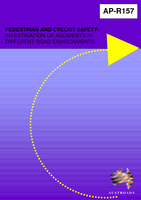Road Safety

Pedestrian and Cyclist Safety: Investigation of Accidents in Different Road Environments
- Publication no: AP-R157-00
- ISBN: 0 85588 543 2
- Published: 1 January 2000
- PDF (free) Download
This report presents the results of a comparison of pedestrian and bicycle casualty accident characteristics in the CBDs, inner metropolitan areas and outer metropolitan areas of Sydney, Melbourne and Brisbane. Preliminary examination of crashes in industrial areas showed that there were too few to make it worth including these areas in the study. The key findings regarding pedestrians are that there was little difference among the cities, particularly when the data was disaggregated by type of area, around half of the pedestrian crashes occur in the inner metropolitan areas of all three cities, and a higher probability that a pedestrian accident would result in a fatality in the outer metropolitan areas. The analysis of bicycle crashes showed generally similar features. Site investigations revealed that high accident sites in the CBD were characterised by high density development and high levels of public transport movements, in the inner metropolitan areas by hotels and strip shopping in well-established residential areas, and outer metropolitan areas by major pedestrian generators in the vicinity such as shopping centres or tertiary education institutions. Features common to high pedestrian and cyclist accident spots in all environments were poor or uneven road surfaces, adverse vertical road alignment; hotels, inadequate kerbside lane width for cyclists, and poor compliance with traffic signals. Many specific recommendations are made.
- AP-R157/00 PEDESTRIAN AND CYCLIST SAFETY: INVESTIGATION OF ACCIDENTS IN DIFFERENT ROAD ENVIRONMENTS
- Foreword
- Executive Summary
- Executive Summaries - related reports
- Contents
- Tables
- Figures
- Acknowledgements
- 1. Introduction
- 2. Methodology
- 3. Previous Studies
- 4. Mass Data Analysis
- 5. Site Inspections
- 6. Summary and Discussion
- 7. Conclusions
- 8. Recommendations
- References
Related publications
Latest Road Safety News
